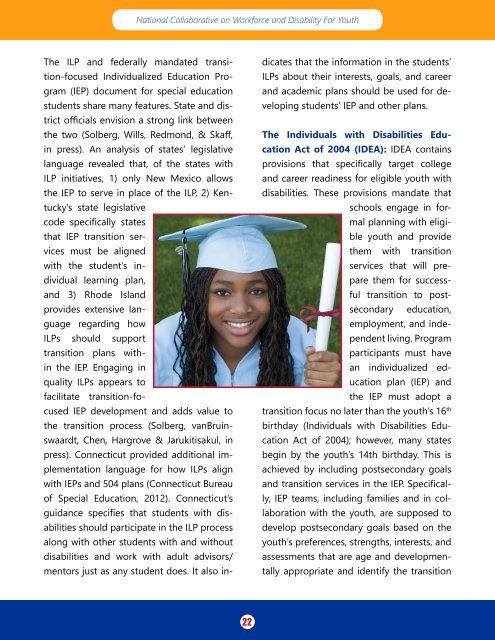Designing Statewide Strategies & Programs
DesigningStatewideCareerDevelopmentStrategiesProgramsPub_0
DesigningStatewideCareerDevelopmentStrategiesProgramsPub_0
Create successful ePaper yourself
Turn your PDF publications into a flip-book with our unique Google optimized e-Paper software.
National Collaborative on Workforce and Disability For Youth<br />
The ILP and federally mandated transition-focused<br />
Individualized Education Program<br />
(IEP) document for special education<br />
students share many features. State and district<br />
officials envision a strong link between<br />
the two (Solberg, Wills, Redmond, & Skaff,<br />
in press). An analysis of states’ legislative<br />
language revealed that, of the states with<br />
ILP initiatives, 1) only New Mexico allows<br />
the IEP to serve in place of the ILP, 2) Kentucky’s<br />
state legislative<br />
code specifically states<br />
that IEP transition services<br />
must be aligned<br />
with the student’s individual<br />
learning plan,<br />
and 3) Rhode Island<br />
provides extensive language<br />
regarding how<br />
ILPs should support<br />
transition plans within<br />
the IEP. Engaging in<br />
quality ILPs appears to<br />
facilitate transition-focused<br />
IEP development and adds value to<br />
the transition process (Solberg, vanBruinswaardt,<br />
Chen, Hargrove & Jarukitisakul, in<br />
press). Connecticut provided additional implementation<br />
language for how ILPs align<br />
with IEPs and 504 plans (Connecticut Bureau<br />
of Special Education, 2012). Connecticut’s<br />
guidance specifies that students with disabilities<br />
should participate in the ILP process<br />
along with other students with and without<br />
disabilities and work with adult advisors/<br />
mentors just as any student does. It also indicates<br />
that the information in the students’<br />
ILPs about their interests, goals, and career<br />
and academic plans should be used for developing<br />
students’ IEP and other plans.<br />
The Individuals with Disabilities Education<br />
Act of 2004 (IDEA): IDEA contains<br />
provisions that specifically target college<br />
and career readiness for eligible youth with<br />
disabilities. These provisions mandate that<br />
schools engage in formal<br />
planning with eligible<br />
youth and provide<br />
them with transition<br />
services that will prepare<br />
them for successful<br />
transition to postsecondary<br />
education,<br />
employment, and independent<br />
living. Program<br />
participants must have<br />
an individualized education<br />
plan (IEP) and<br />
the IEP must adopt a<br />
transition focus no later than the youth’s 16 th<br />
birthday (Individuals with Disabilities Education<br />
Act of 2004); however, many states<br />
begin by the youth’s 14th birthday. This is<br />
achieved by including postsecondary goals<br />
and transition services in the IEP. Specifically,<br />
IEP teams, including families and in collaboration<br />
with the youth, are supposed to<br />
develop postsecondary goals based on the<br />
youth’s preferences, strengths, interests, and<br />
assessments that are age and developmentally<br />
appropriate and identify the transition<br />
22


